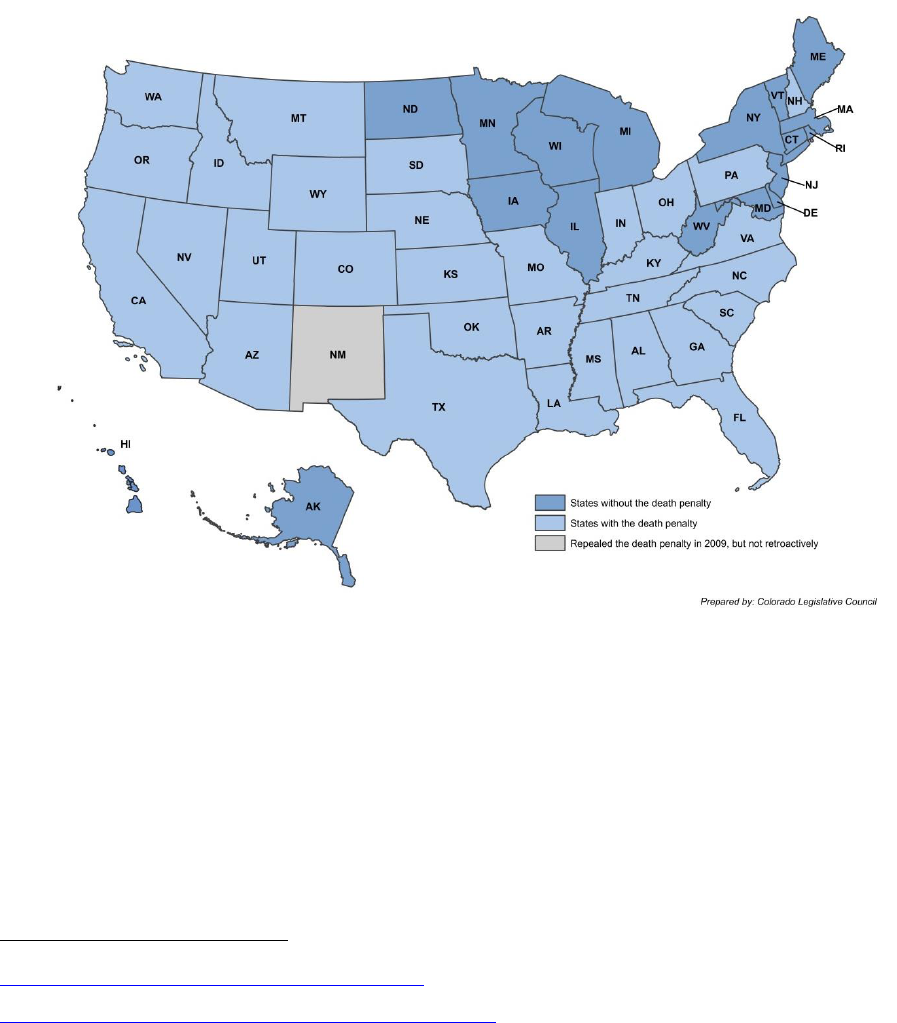
Overview of Capital Punishment Under State and Federal Law 1
Colorado Legislative Council Staff
Interested Persons Memorandum
Overview of Capital Punishment Under State and
Federal Law
Conrad Imel, Research Analyst, (303) 866-2756
July 26, 2017
This memorandum provides
information concerning the use of
capital punishment in Colorado and
across the country. The
memorandum provides a brief history
of Colorado’s death penalty scheme
and information on recent U.S.
Supreme Court decisions concerning
the constitutionality of the death
penalty. It also explains the current
death penalty scheme in Colorado,
including procedures used in
sentencing and required review by
trial courts and the Colorado Supreme
Court. Lastly, this memorandum
provides an overview of capital
punishment in other states and federal
death penalty laws.
The death penalty has been a
sentencing option in the United States
since the country’s founding: the first
Congress made treason, piracy,
murder within federal enclaves, as
well as forgery and counterfeiting of federal certificates and public securities, punishable by
death.
1
Even prior to achieving independence, every colony punished at least some crimes by
execution — laws that were carried into the new nation. The first state to abolish the death
penalty was Michigan, which did so in 1846 for all crimes, except treason. Near the beginning
of the twentieth century, many states abolished the death penalty, though most reinstated it
later. Today, 31 states authorize the use of capital punishment; the federal government has
always had a death penalty.
Peak execution rates in the U.S. occurred during the 1930s, with 199 people executed in
1935. In the modern era, executions peaked in 1999, when there were 98 executions, the most
of any year since 1976. Since then, the number of executions nationwide has decreased almost
every year; in 2016 there were a total of 20 executions, the fewest since 1991. Similarly, there
were only 20 death sentences issued in 2016, the fewest in more than four decades. Recent
concerns over lethal injection drug availability have caused some states to increase the number
of executions carried out before such drugs expire.
1
Charles Doyle, Congressional Research Service, Federal Capital Offenses, Nov. 17, 2011. This interested persons memorandum
uses the terms “death penalty” and “capital punishment” interchangeably.
Table of Contents
Section 1: History of the Death Penalty in Colorado 2
Section 2: Constitutionality of Capital Punishment 3
Section 3: Death Penalty in Colorado 5
Trial and Sentencing
Review of Death Sentences
Enforcement of Capital Punishment
Colorado Legislation concerning Capital Punishment
Section 4: Capital Punishment in Other Jurisdictions 10
Capital Punishment in Other States
Federal Capital Offenses
Appendix A – Aggravating Factors Under
Section 18-1.3-1201 (5), C.R.S. 13
Appendix B – Mitigating Factors Under
Section 18-1.3-1201 (4), C.R.S. 14
Appendix C – Colorado Death Penalty Legislation,
1976 to 2017 15
Appendix D – Methods of Execution, by Jurisdiction 16
Appendix E – Executions by State, 1977 through
July 7, 2017 17

Overview of Capital Punishment Under State and Federal Law 2
Section 1: History of the Death Penalty in Colorado
Colorado’s experience with capital punishment began before statehood. In 1859, John
Stoefel was executed as punishment for his commission of the first recorded murder in the new
settlement of Denver, then a part of the Kansas Territory.
2
After the Colorado Territory was
formed, the first territorial legislature enacted the legislation authorizing the death penalty.
3
Colorado was granted statehood in 1876, and its First General Assembly enacted laws
authorizing the use of capital punishment against those convicted of murder.
4
At this time, the
death penalty was carried out by counties as a public hanging. In 1883, the General Assembly
first introduced degrees of murder, with death serving as punishment for first degree murder.
5
Six years later, executions were moved away from public view in various counties, to a single
private location inside the state penitentiary in Cañon City.
6
In 1896, Colorado executed three
codefendants for the murder of a Trinidad police officer. These were the final executions prior
to Colorado’s repeal of capital punishment.
7
Abolition of capital punishment, 1897-1901, and reinstatement. Twice during the 1890s,
the state Senate approved of measures to repeal the death penalty in Colorado that were
defeated in the House of Representatives. After those failed efforts, capital punishment was
finally abolished in 1897.
8
Four years later, in 1901, the death penalty was reinstated as a
punishment, after the General Assembly passed a bill, and the Governor allowed it to become
law without his signature.
9
Between reinstatement and 1933, executions in Colorado were
carried out by hanging. Beginning in 1934, Colorado utilized asphyxiation, via gas chamber, to
carry out death sentences.
10
There were many efforts in the 1950s and 1960s to repeal Colorado’s death penalty. For
example, bills to affect such change were introduced and defeated in 1955, 1956, 1959, and
1961. In 1964, two bills, one a permanent repeal and another that was a five-year moratorium
on capital punishment, were similarly defeated. In 1965, a bill was adopted that referred to
Colorado voters a ballot question to permanently repeal the capital punishment. After passage
of the bill, Governor John Love announced a moratorium on the death penalty until citizens
voted on the measure. In the 1966 election, the referendum failed by a wide margin, and the
Governor lifted the moratorium on executions.
11
The final execution by asphyxiation in Colorado took place on June 2, 1967, when an
offender was executed for committing murder. That would turn out to be the final execution in
Colorado for 30 years, and because of federal court decisions, the last one in the United States
for nearly a decade.
12
2
Radelet, Michael, Capital Punishment in Colorado: 1859-1972, 74 U. Colo. L. Rev. 885, 885 (2003).
3
1861 Colo. Terr. Sess. Laws 290, 293.
4
Colo. Gen. Laws. Ch. XXVI, §§ 20 and 268 (1877).
5
1883 Colo. Sess. Laws 150. First degree murder included all murder perpetrated “by means of willful, deliberate and premeditated
killing; or which is committed in the perpetration or attempt to perpetrate any arson, rape, robbery, mayhem or burglary; or
perpetrated from a deliberate and premeditated design, unlawfully and maliciously to effect the death of any human being other than
him who is killed; or perpetrated by any act greatly dangerous to the lives of others, and indicating a depraved mind regardless of
human life,” all other murder was murder in the second degree, which was punishable by imprisonment for 10 years to life.
6
1889 Colo. Sess. Laws 118.
7
Radelet, Capital Punishment in Colorado, at 907.
8
Ch. 35, 1897 Colo. Sess. Laws 135.
9
Ch. 64, 1901 Colo. Sess. Laws 153-54. Radelet, Capital Punishment in Colorado, at 912.
10
Ch. 61, 1933 Colo. Sess. Laws, 420-22
11
Radelet, Capital Punishment in Colorado, at 923-30.
12
Radelet, Capital Punishment in Colorado, at 922.

Overview of Capital Punishment Under State and Federal Law 3
Section 2: Constitutionality of Capital Punishment
The U.S. Supreme Court addressed the constitutionality of capital punishment in 1972. That
year, in Furman v. Georgia, the Court held that the manner in which the death penalty was
being applied in the three specific cases before it violated the Eighth Amendment to the U.S.
Constitution.
13
The Court’s unsigned per curium opinion provided no reasoning, though each of
the nine justices wrote separate concurring or dissenting opinions.
States generally took two approaches in response
to Furman. The first approach was to remove arbitrary
application of the death penalty by making it mandatory
in certain cases. The Supreme Court rejected this
approach, holding that mandatory death sentence
statutes violate the Eighth and Fourteenth
Amendments.
14
The second approach was to make the
punishment apply in a more narrow set of cases, and
provide rules that would guide jury discretion
determining whether to sentence a defendant to death.
Colorado took this second approach, rewriting its law to
require the finding of at least one aggravating factor in
order to impose capital punishment, and providing a list
of mitigating factors to be considered when determining
an offender’s sentence. Under that Colorado law, a
finding of any mitigating factor would prohibit a death
sentence.
15
In 1976’s Gregg v. Georgia, the U.S. Supreme
Court approved of the second approach, upholding as
constitutional Georgia’s capital punishment scheme
that it described as focusing the jury’s attention on the
specific crime committed and particular defendant. The
Court also approved of the Georgia law’s provisions
that “channeled” the jury’s discretion by requiring it to
find an aggravating offense as a condition of
sentencing a person to death and permitting jurors to
consider mitigating circumstances; and required review
by the Georgia Supreme Court.
16
Since Gregg, the federal government and the states have been permitted, under the U.S.
Constitution, to enact capital punishment schemes that conform to the guidance offered by the
U.S. Supreme Court. Legal challenges continue to be brought concerning a number of issues
relating to the imposition of capital punishment. The following sections discuss court decisions
and Colorado law concerning how certain judgments relating to death sentencing are made,
who may be sentenced to death, and the methods of execution that may be used.
Court decisions and Colorado law concerning determining facts that result in capital
punishment. Until 1995, Colorado law required a jury to perform sentencing in death penalty
cases, unless there was no jury, in which case a judge could impose a death sentence. In
1995, the law was amended to have a three-judge panel make sentencing determinations. The
13
Furman v. Georgia, 408 U.S. 238 (1972). As it is relevant to death penalty cases, the Eighth Amendment prohibits the infliction of
cruel and unusual punishment.
14
Woodson v. North Carolina, 428 U.S. 280 (1976).
15
Ch. 52, 1974 Colo. Sess. Laws 240. The list of mitigating factors includes that the defendant is a juvenile or that his or her
capacity to appreciate the wrongfulness of his or her conduct or conform to the law was significantly impaired.
16
Gregg v. Georgia, 428 U.S. 153, 206-07 (1976).
Summary of Capital Punishment
in the United States, 1967-77
1967: Colorado executes final
prisoner in the U.S. prior to the
decision by the U.S. Supreme
Court invalidating the practice.
1972: In Furman v. Georgia, the
Court finds the death penalty
unconstitutional as applied to
the three cases before it,
effectively ending the practice
nationwide.
1972-76: States enact new
capital sentencing schemes in
an effort to comport with the
U.S. Constitution.
1976: The Court approves of
Georgia’s capital sentencing
scheme in Gregg v. Georgia.
1977: Executions resume in the
United States when Utah puts
an offender to death by firing
squad.

Overview of Capital Punishment Under State and Federal Law 4
law required the panel of judges to reach a unanimous verdict on sentencing; otherwise, the
court was required to sentence the defendant to life in prison.
17
This was Colorado law at the
time of the U.S. Supreme Court’s 2002 decision in Ring v. Arizona, in which the Court ruled that
the Sixth Amendment to the U.S. Constitution requires that aggravating circumstances
necessary for imposition of the death penalty be found by a jury, not a judge.
18
This ruling
prompted states, including Colorado, to change their laws to require that a jury make sentencing
decisions in death penalty cases.
Following the Ring decision, Colorado Governor Bill Owens called a special legislative
session.
19
The General Assembly convened on July 8, 2002, and amended Colorado law to
again require the trial jury to perform sentencing.
20
Under this law, when the jury cannot reach a
unanimous sentencing decision, the court is required to sentence the defendant to life in prison.
This remains current Colorado law.
In 2016, the Court reaffirmed Ring, and overturned Florida’s death penalty sentencing
scheme, which required the judge alone to find the existence of an aggravating circumstance
necessary to impose a death penalty.
21
Court decisions and Colorado law concerning minors and persons with mental
disabilities. In addition to cases involving death penalty sentencing procedures, the
U.S. Supreme Court also hears cases that consider the application of the death penalty. In
2005, the Court held that the U.S. Constitution prohibits the execution of offenders who were
sentenced to death for a crime committed while the offender was under the age of 18.
22
In
2002, the Court held that the U.S. Constitution restricts states’ power to sentence an
intellectually disabled offender to death.
23
Under current Colorado law, an offender convicted as an adult of a class 1 felony that was
committed while the offender was a juvenile, or an offender convicted of a class 1 felony who is
determined to be “mentally retarded,” is not subject to the death penalty, and is instead
sentenced to life imprisonment with the possibility of parole after 40 years.
24
Recent issues concerning lethal injection. Each jurisdiction that permits capital
punishment, including Colorado, uses lethal injection as its primary method of carrying out the
death penalty.
25
The U.S. Supreme Court has heard challenges to the procedures used for
lethal injection. In 2008, the Court upheld the use of lethal injection as a means of execution in
Baze v. Rees.
26
In Baze, the Court specifically upheld Kentucky’s use of lethal injection against
claims that the procedure could cause severe pain to the executed offender if administered
improperly. The Court found that the first drug in a three-drug combination used for injection,
sodium thiopental, was sufficient to mitigate the pain suffered by the offender.
17
Section 16-11-103 (2)(d), C.R.S. (1995).
18
Ring v. Arizona, 536 U.S. 584 (2002).
19
Channel 7, “Special Session Set for Death Penalty, Fires,” June 27, 2002, http://www.thedenverchannel.com/news/special-
session-set-for-death-penalty-fires, retrieved February 21, 2017.
20
During the special session, the General Assembly enacted House Bill 02S-1005, which amended Section 16-11-103 (2)(d), C.R.S.
(2001), effective July 12, 2002. On October 1, 2002, that amended section was relocated to Section 18-1.3-1201 (2)(d), C.R.S.
(2002) in accordance with a bill passed during the 2002 regular session. Section 12 of HB 02S-1005 stated the General Assembly’s
intent that there be no hiatus in the imposition of the death penalty as a result of the decision in Ring v. Arizona.
21
Hurst v. Florida, 136 S.Ct. 616 (2016). Colorado law permits a defendant to waive the right to a jury and have guilt and sentencing
decisions made by a judge. These provisions have not been reviewed by a court in light of the U.S. Supreme Court’s Hurst
decision.
22
Roper v. Simmons, 543 U.S. 551, 578 (2005).
23
Atkins v. Virginia, 536, U.S. 304, 321 (2002), internal quotations omitted. A later case, Hall v. Florida, 134 S. Ct. 1986 (2014),
explored the constitutionality of Florida’s method to determine when an offender should be considered intellectually disabled.
24
Section 18-1.3-401 (4)(b), C.R.S. (juveniles); Section 18-1.3-1103, C.R.S. (“mentally retarded” defendants).
25
Information on state and federal methods of execution is available in Appendix D. Colorado adopted lethal injection as the means
for execution in 1988.
26
Baze v. Rees, 553 U.S. 35 (2008).

Overview of Capital Punishment Under State and Federal Law 5
After the Court’s Baze decision, sodium thiopental became increasingly unavailable.
Consequently, some states have turned to a different drug, midazolam, in order to limit pain in
executions. Complications have occurred in executions where midazolam was used, which
prompted offenders sentenced to death in Oklahoma to challenge the state’s use of the drug. In
2015’s Glossip v. Gross decision, the Court upheld Oklahoma’s use of midazolam in part
because it was not established “that any risk of harm was substantial when compared to a
known and available alternative method of execution.”
27
Although the U.S. Supreme Court has never overturned a state’s method of execution as
cruel and unusual punishment, a number of states have determined secondary methods in case
a court finds its primary method unconstitutional.
28
For example, Wyoming uses lethal injection
as its primary method for imposing the death penalty, but if a court holds that method
unconstitutional, then lethal gas would be used. Oklahoma provides four methods of execution:
lethal injection, asphyxiation, electrocution, and firing squad; prioritized in that order, to be used
in case the method before it is found unconstitutional. Colorado law requires capital punishment
to be carried out by lethal injection, and does not provide for alternative methods under any
circumstances. However, while the law mentions the use of sodium thiopental, any other
equally or more effective substance may be used.
29
Methods of execution authorized by each
state are listed in Appendix D.
Section 3: Death Penalty in Colorado
Trial and Sentencing
Under Colorado law, adult offenders convicted of class 1 felonies are subject to be
sentenced to death.
30
An offender convicted as an adult of a class 1 felony that was committed
while the offender was a juvenile, or an offender convicted of a class 1 felony who is determined
to be “mentally retarded,” is not subject to the death penalty, and is instead sentenced to life
imprisonment with the possibility of parole after 40 years.
31
Prior to seeking the death penalty in a case, the prosecutor must notify the defendant that
he or she will seek such punishment. Then, the defendant’s guilt is determined in a trial.
Following conviction, the sentencing phase of the trial is conducted before the trial jury to
determine whether the defendant should be sentenced to death or life imprisonment.
Pretrial notification and trial. Prosecutors in Colorado have the discretion to determine
whether to seek the death penalty in a class 1 felony case. Under court rules, if the prosecuting
attorney wishes to seek the death penalty in a case, he or she must file a written statement of
intention to seek the death penalty to the court and defendant within nine weeks of the
defendant’s arraignment.
32
27
Glossip v. Gross, 135 S. Ct. 2726 (2015).
28
Ibid. at 2732 (“[The U.S. Supreme] Court has never invalidated a State’s chosen procedure for carrying out a sentence of death
as the infliction of cruel and unusual punishment,” quoting Baze).
29
Wyo. Stat. § 7-13-904; Okla. Stat. Ann. tit. 22, § 1014; Section 18-1.3-1202, C.R.S.
30
Section 18-1.3-401, C.R.S.
31
Section 18-1.3-401 (4)(b), C.R.S. (juveniles); Section 18-1.3-1103, C.R.S. (“mentally retarded” defendants).
32
Colo. R. Crim. P. 32.1 (b).
Pretrial
Trial
Sentencing
Trial Court
Review
Supreme Court
Review
Execution
Governor’s Review

Overview of Capital Punishment Under State and Federal Law 6
Except for when a defendant pleads guilty to a crime, guilt is determined when he or she is
tried before a jury. Like any other defendants, those accused of committing an offense for
which the death penalty is sought have the right to a jury trial. Unlike defendants accused of
other crimes, Colorado law prohibits defendants accused of class 1 felonies from waiving that
right.
33
Defendants in class 1 felony cases must have a jury of twelve, and cannot elect to have
fewer jurors empaneled.
34
Generally, the same procedures are used during the trial to
determine guilt in a capital punishment case as are used in any other trial.
Capital sentencing procedures under Colorado law. Following a conviction for a class 1
felony, the sentencing phase begins “as soon as practicable” to the conclusion of the trial.
35
The sentencing hearing is held before the trial judge and trial jury, including alternate jurors.
36
In order to sentence a person to death, the jury must unanimously find and specify in writing that
at least one aggravating factor has been proved and that there are no mitigating factors that
sufficiently outweigh the aggravating factors. If the jury does not find that an aggravating factor
has been proven beyond a reasonable doubt or that mitigating factors outweigh any aggravating
factors, it must sentence the defendant to life imprisonment. Similarly, if the jury’s decision to
impose the death penalty is not unanimous, the offender is sentenced to life imprisonment.
37
Aggravating and mitigating factors. As stated above, Colorado law requires that a jury
find at least one aggravating factor in order to impose the death penalty. Aggravating factors
that the jury may consider include: that the defendant has a prior conviction for a class 1 or 2
felony; the defendant committed the offense while lying in wait, from ambush, or by use of an
explosive or incendiary device or a chemical, biological, or radiological weapon; the defendant
killed two or more people in the same criminal episode or more than one person in more than
one criminal episode; the victim was younger than 12 years old; the offense was committed
against the victim because of the victim’s race, color, ancestry, religion, or national origin; or that
the defendant committed the offense in an especially heinous, cruel, or depraved manner. A
complete list of aggravating factors can be found in Appendix A.
State law also permits an offender to present mitigating factors to outweigh proven
aggravating factors. Mitigating factors include: the defendant’s age at the time of the offense;
the emotional state of the defendant at the time of the offense; the absence of a prior conviction;
the defendant’s cooperation with law enforcement; that the defendant is not a continuing threat
to society; and any other evidence that bears on the question of mitigation. A complete list of
mitigating factors can be found in Appendix B.
Scheduling execution and stay. If the jury does find at least one aggravating factor and
no mitigating factors, and it reaches its decision unanimously, it may sentence an offender to
death. If the jury does so, the trial court must set a week of execution, the end of which is
between 91 and 126 days from the sentencing.
38
The court must also stay the execution and
immediately notify the Colorado Supreme Court of the judgment.
33
U.S. Const. amend. VI; Colo. Const. art. 2, § 23; Section 16-10-101, C.R.S. [right to trial]; Section 18-1-406 (2), C.R.S. [waiver].
34
Section 18-1-406, C.R.S.
35
Part 12 of Title 1.3 of Article 18, C.R.S., covers sentencing in class 1 felony cases. Colorado Rule of Criminal Procedure 32.1
relates to death penalty sentencing hearings.
36
Section 18-1.6-1201 (1)(a), C.R.S., permits sentencing to be performed before the trial judge if the defendant has waived a jury
trial or has plead guilty. However, under Colorado law, defendants in class 1 felony cases cannot waive a jury trial. Similarly,
Section 18-1.3-1201 (2.5), C.R.S., sets forth procedures for a judge to sentence an offender to the death penalty when the trial was
before a judge and not a jury. This provision has not been utilized or reviewed by a court in light of recent U.S. Supreme Court
decisions requiring juries to make certain determinations regarding a death sentence.
37
Section 18-1.3-1201 (2), C.R.S.
38
Section 16-12-204 (1), C.R.S.; Section 18-1.3-1205, C.R.S.
Pretrial
Trial
Sentencing
Trial Court
Review
Supreme Court
Review
Execution
Governor’s Review

Overview of Capital Punishment Under State and Federal Law 7
Review of Death Sentences in Colorado
Colorado law provides for an expedited system of unitary review in death penalty cases,
which is the only review available for death penalty sentences.
39
This system provides for
postconviction review by the trial court of certain specified issues, and appellate review by the
Colorado Supreme Court of any issues raised during the plea, pre-trial, trial, penalty, and new
trial motion phases of the proceedings, as well as the trial court’s postconviction review.
Postconviction review by the trial court. Colorado law authorizes the trial court to
provide postconviction review of capital punishment determinations. At a hearing following the
imposition of a death sentence, trial courts are required to advise the defendant of the nature of
court review prescribed by state law, the right to counsel on direct appeal to the Colorado
Supreme Court, and the availability of review of ineffective assistance of counsel claims. At the
same hearing, the court must determine whether the defendant intends to pursue postconviction
review and, if so, whether he or she intends to proceed without counsel.
40
A defendant may
continue to use his or her trial counsel, or obtain new counsel for postconviction review. The
court may appoint new counsel for postconviction review for indigent defendants.
41
A motion for postconviction review may only raise issues permitted by Colorado law.
Defendants may seek review on whether there is evidence, not previously presented, that
requires that the conviction or the death sentence be vacated in the interests of justice, but only
if the defendant or his or her attorney could not have known or learned of the facts, with the
exercise of reasonable diligence, prior to sentencing. Defendants may also raise issues related
to whether the defendant was convicted for constitutionally protected conduct, and the
constitutionality of the conviction, sentence, or statute under which the defendant was
convicted. Colorado law also permits postconviction review of whether the trial court had
jurisdiction over the defendant or subject matter of the case; whether trial counsel rendered
ineffective assistance; and for any other grounds that may properly be the basis for an attempt
to overturn the criminal judgment during another proceeding.
42
Colorado Supreme Court review. Defendants who choose to appeal death sentences do
so directly to the Colorado Supreme Court, bypassing review by the Colorado Court of Appeals.
The Supreme Court also directly hears appeals of the trial court’s postconviction review. A
defendant must file a notice of appeal with the Colorado Supreme Court within seven days of
the trial court’s order on postconviction review motions. If no postconviction review motions are
filed, the defendant must file the notice of appeal within seven days of the deadline for filing
postconviction review motions.
43
39
Section 16-12-202 (1), C.R.S. Generally, reviewing courts are limited to issues before it in the reviewed case. Unitary review
allows for a reviewing court to make determinations on issues that may be the basis for an attempt to overturn the criminal judgment
during another proceeding.
40
Section 16-12-204 (2), C.R.S.
41
Section 16-12-205, C.R.S.
42
Section 16-12-206 (1)(c), C.R.S.
43
Colo. R. Crim. P. 32.2 (c).
Pretrial
Trial
Sentencing
Trial Court
Review
Supreme Court
Review
Execution
Governor’s Review
Pretrial
Trial
Sentencing
Trial Court
Review
Supreme Court
Review
Execution
Governor’s Review

Overview of Capital Punishment Under State and Federal Law 8
Any appeals by the defendant, both direct appeals and those of postconviction review, to the
Supreme Court are consolidated into one proceeding before the court. The prosecution may
appeal to the Supreme Court trial court rulings granting a motion for a new trial, postconviction
relief, or other relief; or a ruling that any statute is inoperative or unconstitutional.
44
Further, the
General Assembly has stated its intent that the Supreme Court give priority to death penalty
appeals over all other cases before the court, and it urges the court to render decisions in such
cases expeditiously.
45
Colorado law permits the Supreme Court to overturn a death sentence if it was imposed
under the influence of passion, prejudice, or any other arbitrary factor, or that the evidence
presented does not support the finding of an aggravating circumstance. If the Supreme Court
finds that the evidence in a case does not support finding an aggravated factor, the court may
still uphold the death sentence by determining that the jury would have sentenced the defendant
to death without that aggravating factor or reweighing any remaining aggravating factor or
factors and all mitigating factors, and then determining whether death is the appropriate
punishment in the case. If the jury considered an aggravating factor in an impermissibly broad
manner, the court may also uphold the sentence if it determines that the jury would have
sentenced the defendant to death had the factor been properly considered.
46
Governor’s review. The Colorado Constitution empowers the Governor to grant reprieves,
commutations, and pardons for all offenses, except treason and impeachment.
47
A reprieve is a
temporary suspension of a sentence. Commutation and pardon are two types of clemency.
State law authorizes the Governor to commute the sentence in a capital case to imprisonment
for life or a minimum 20 years at hard labor, and provides the procedures by which a convicted
offender may seek commutation.
48
A pardon issued by the Governor waives all “collateral
consequences” associated with a conviction, including any penalties, prohibitions, bars,
disadvantages, or disqualifications imposed based on the conviction.
49
Enforcement of Capital Punishment in Colorado
Colorado law requires that lethal injection be used to carry out the death penalty. The law
specifies a “continuous intravenous injection of a lethal quantity of sodium thiopental or equally
or more effective substance to cause death.” Death sentences are carried out at the
Department of Corrections (DOC) facility at Cañon City by a person trained to administer
intravenous injections. Death is pronounced by a licensed physician or coroner. As explained
above, the trial court sets the week of execution, which is immediately stayed. The day and
hour of the execution is set by the DOC’s executive director, or his or her designee. That
person, along with a physician, guards, attendants, and any other person necessary to carry out
the execution may be present. The DOC executive director may permit up to 18 witnesses to
attend as well. Prior to the execution, the Judicial Branch is required collect and test a
biological sample from the convicted offender to determine his or her genetic markers. The
DOC is required to collect and maintain certain records concerning the execution.
50
44
Section 16-12-207, C.R.S.
45
Section 16-12-208 (5), C.R.S.
46
Section 18-1.3-1201 (6) and (8), C.R.S.
47
Colo. Const. art. IV, § 7.
48
Section 16-17-101, C.R.S. (Governor’s authority); Section 16-17-102, C.R.S. (procedures).
49
Section 16-17-103, C.R.S.
50
Section 18-1.3-1202, et seq., C.R.S.
Pretrial
Trial
Sentencing
Trial Court
Review
Supreme Court
Review
Execution
Governor’s Review

Overview of Capital Punishment Under State and Federal Law 9
Current gubernatorial moratorium. In May 2013, Governor John Hickenlooper, by
executive order, granted a reprieve to Nathan Dunlap, the only inmate on death row who has
exhausted all available court procedures. By its terms, the order remains in effect until
rescinded by another executive order of the Governor. In the order, Governor Hickenlooper’s
stated reasons for granting the reprieve include the inconsistent application of the death penalty
in Colorado, the “finality” of the sentence, religious views that are contrary to capital
punishment, that the state “is not immediately equipped to carry out a death sentence,” and that
the death penalty is not a deterrent.
51
Because of Governor Hickenlooper’s reasoning, and
because the order may be in force indefinitely, the order has been called a moratorium on the
death penalty in Colorado. This moratorium is based on Governor Hickenlooper’s decision to
grant a reprieve to an offender subject to the penalty, and may be lifted at his discretion, or that
of subsequent Governors.
Execution in Colorado. Since the death penalty was reinstated in 1976, Colorado has
executed one man who was sentenced to death. Gary Lee Davis was executed in 1997
following his convictions on charges of first-degree murder, felony murder, conspiracy to commit
murder in the first degree, second-degree kidnapping, and conspiracy to commit second-degree
kidnapping. As of June 2017, three inmates are on Colorado’s death row, including Mr. Dunlap,
who was granted a reprieve, and two other convicted offenders whose sentences are stayed
pending ongoing legal appeals.
Colorado Legislation Concerning Capital Punishment
Since 1976, the Colorado General Assembly has undertaken death penalty reform efforts on
many occasions. Appendix C provides information on death penalty legislation since 1976.
Recently, the legislature has considered a number of bills that would affect or repeal the death
penalty.
Recent legislation to reform capital punishment procedures. Since 2014, the General
Assembly has considered four bills that would have affected procedures or review for death
penalty cases; none of those bills was adopted. In 2016, the General Assembly rejected two
bills concerning death penalty sentencing procedures. House Bill 16-1233 would have split the
sentencing phase of a death penalty trial into two distinct phases: an aggravating phase and a
mitigating phase. Senate Bill 16-064 would have required only nine jurors to agree to the
imposition of the death penalty. Both bills failed to pass out of committee.
The General Assembly considered bills relating to review of death sentences during the
2014 legislative session. House Bill 14-1197 would have limited the Governor to a single
reprieve to an offender sentenced to death, granted for cause. Senate Bill 14-069 would have
set specific deadlines for the Colorado Supreme Court to hear appeals in death penalty cases.
Both of these bills failed to pass out of committee.
Efforts to repeal the death penalty in Colorado. Since 2013, the General Assembly has
considered three bills to repeal the death penalty. House Bill 13-1264 and Senate Bill 17-095
would have repealed the death penalty. House Bill 13-1270 would have repealed the death
penalty, contingent upon passage of a statewide ballot measure in the November 2014 general
election. All three bills failed to pass out of committee.
51
Office of the Governor, State of Colorado, “Death Sentence Reprieve,” Exec. Order D 2013-006 (May 22, 2013).

Overview of Capital Punishment Under State and Federal Law 10
Section 4: Capital Punishment in Other Jurisdictions
Capital Punishment in Other States
Thirty-one states, including Colorado, permit the death penalty as punishment for criminal
offenses, as shown on the map below. Each of those states utilizes lethal injection as the
primary form of execution. Fourteen states have alternative methods of execution in the event
that lethal injection is not available, the inmate wishes to select an alternate method, or for
offenders sentenced prior to the introduction of lethal injection. Alternative methods include
electrocution, lethal gas, hanging, and firing squad. A complete list of states that permit capital
punishment, and their methods of execution, is available in Appendix D.
Figure 1
States with Capital Punishment, 2017
Prisoners on death row and executions since 1976. As of October 1, 2016, there were
2,902 inmates on death row in the United States.
52
Between reinstatement of the death penalty
in 1976 and May 17, 2017, a total of 1,453 inmates have been executed nationwide. Texas
carried out the most executions of any state during that time, putting 542 inmates to death.
53
The number of executions in each state since 1976 is listed in Appendix E.
Recent efforts to repeal the death penalty in other states. Generally, capital punishment
may be abolished by legislative action, ballot initiative or referendum, or judicial action. Four
states — New Mexico (2009), Illinois (2011), Connecticut (2012) and Maryland (2013) — have
legislatively abolished the death penalty in recent years. The Nebraska Legislature repealed
the death penalty in 2015, requiring an override of the Governor’s veto to do so. However, in
52
The Criminal Justice Project, NAACP Legal Defense and Educational Fund, Death Row U.S.A., Fall 2016, available at:
https://deathpenaltyinfo.org/documents/DRUSAFall2016.pdf.
53
Death Penalty Information Center, Number of Executions by State and Region Since 1976, webpage,
https://deathpenaltyinfo.org/number-executions-state-and-region-1976.

Overview of Capital Punishment Under State and Federal Law 11
the 2016 general election, Nebraska’s voters chose to defeat the legislature’s action and keep
the death penalty as a punishment for first degree murder in the state.
54
In addition to Nebraska, voters in two other states acted on ballot questions concerning
capital punishment during the 2016 general election. California voters rejected Proposition 62,
which would have abolished the death penalty. In the same election, voters approved
Proposition 66, which sought to shorten the time spent on legal challenges to death sentences.
In Oklahoma, State Question 776 passed, adding to the state constitution a declaration that the
death penalty is not cruel and unusual punishment.
In Delaware, capital punishment was repealed by judicial decision. In August 2016, the
Delaware Supreme Court held that the state’s death penalty scheme was unconstitutional
because it violated the Sixth Amendment to the U.S. Constitution by permitting judges, not
juries, to find certain facts necessary to impose a death sentence.
55
In December 2016, the
Delaware Supreme Court held that its ruling applied retroactively, so the remaining offenders
sentenced to death would instead receive sentences of life imprisonment without parole,
probation, or any other reduction.
56
Federal Capital Offenses
Federal capital cases are governed by the Federal Death Penalty Act. Under federal law,
the death penalty may apply in cases of treason, espionage, homicide, and certain drug
offenses.
57
In federal death penalty-eligible cases, the U.S. Attorney General determines
whether to seek the death penalty.
58
There is no statute of limitations for federal capital
offenses.
59
Pregnant women; a person who is “mentally retarded,” or a person who, as a result
of mental disability, lacks the mental capacity to understand the death penalty and why it was
imposed; a person who committed the capital offense while under the age of 18; and certain
Native Americans are not subject to the federal death penalty.
60
Federal capital sentencing and review. In federal cases, when the prosecutor provides
notice of intent to seek the death penalty, a sentencing phase follows a conviction for a death
penalty-eligible offense. In order for the offender to be sentenced to death, the prosecution
must prove at least one aggravating factor, and the proved aggravating factors must sufficiently
outweigh any mitigating factors to justify imposing a death sentence.
61
In cases of homicide,
certain intent must also be proved.
62
Offenders sentenced to death are entitled to appellate
review of their sentences.
63
Imposition of the federal death penalty. If the sentence is upheld, the U.S. Marshals
Service supervises the implementation of the death sentence in accordance with the law of the
state in which the sentence is imposed, or, if that state does not permit capital punishment,
pursuant to the laws of another state, as determined by a court.
64
The U.S. Marshals Service is
permitted to use state and local facilities and personnel to carry out the sentence.
65
54
Nebraska Referendum 426, Nebraska Secretary of State, Revised Official Report of the Board of State Canvassers, p. 60,
available at: http://www.sos.ne.gov/elec/2016/pdf/2016-canvass-book.pdf.
55
Rauf v. State, 145 A.3d 430 (Del. 2016).
56
Powell v. State, 153 A.3d 69 (Del. 2016).
57
18 U.S.C. § 3591 (a).
58
U.S. Dept. of Justice, United States Attorney Manual, §§ 9-10.050 (Apr. 2014) and 9-10.160 (Jan. 2017), available at:
https://www.justice.gov/usam/united-states-attorneys-manual.
59
18 U.S.C. § 3281.
60
18 U.S.C. § 3591 [under 18 at the time of offense]; 18 U.S.C. § 3596 (b) [pregnant women]; 18 U.S.C. § 3596 (c) [“mentally
retarded” persons]; and 18 U.S.C. § 3598 [Native Americans in certain circumstances].
61
18 U.S.C. § 3593 (e). Aggravating and mitigating factors may be found in 18 U.S.C. § 3592.
62
18 U.S.C. § 3591 (a)(2).
63
18 U.S.C. § 3595 (a).
64
18 U.S.C. § 3596.
65
18 U.S.C. § 3597.

Overview of Capital Punishment Under State and Federal Law 12
Federal execution. Since the 1988 adoption of the Federal Death Penalty Act, 76
defendants have been sentenced to death. Of those 76 sentenced, 11 have been removed
from death row, and 3 have been executed. The remaining 62 prisoners are on federal death
row.
66
Each of the prisoners on death row was convicted of crime involving homicide, some of
which were drug-related; none involves espionage or treason. The prisoners who have been
removed from death row have either been resentenced after appeal to life in prison, had their
sentences commuted to life in prison, or have died while on death row. Of the three executions
since 1988, two were carried out in June 2001, and the most recent federal execution occurred
in March 2003.
67
66
The 62 inmates on death row includes those who have received a death sentence from a jury, but have not been formally
sentenced by a judge; those who may still have appeals pending or available, which may affect the death sentence; and those who
may have had their death sentences reversed, but prosecutors either have appealed the reversal or can still seek the death penalty
in a resentencing hearing.
67
Death Penalty Information Center, Federal Death Row Prisoners, (updated Feb. 9, 2017), http://deathpenaltyinfo.org/federal-
death-row-prisoners.
Overview of Capital Punishment Under State and Federal Law 13
Appendix A
Aggravating Factors Under Section 18-1.3-1201 (5), C.R.S.
The following are aggravating factors under Colorado law:
the offense was committed by a person under sentence of imprisonment for a class 1, 2,
or 3 felony, or for a crime committed against another state or the United States which
would constitute a class 1, 2, or 3 felony;
the defendant was previously convicted in Colorado or any other state of a class 1 or 2
felony involving violence, as defined by Colorado law;
the defendant intentionally killed any of the following persons while the person was
engaged in the course of the performance of the person's official duties, and the
defendant knew or reasonably should have known that the victim was a person engaged
in the performance of the person's official duties, or the victim was intentionally killed in
retaliation for the performance of the victim's official duties:
o a peace officer or former peace officer;
o a firefighter;
o an emergency medical service provider;
o a judge, referee, or former judge or referee of any court of record in the state or
federal system or in any other state court system or a judge or former judge in any
municipal court in this state or in any other state;
o an elected state, county, or municipal official; or
o a federal law enforcement officer or agent or former federal law enforcement officer
or agent;
the defendant intentionally killed a person kidnapped or being held as a hostage by the
defendant or by anyone associated with the defendant;
the defendant has been a party to an agreement to kill another person in furtherance of
which a person has been intentionally killed;
the defendant committed the offense while lying in wait, from ambush, or by use of an
explosive or incendiary device or a chemical, biological, or radiological weapon;
the defendant committed a class 1, 2, or 3 felony and, in the course of or in furtherance
of such or immediate flight therefrom, the defendant intentionally caused the death of a
person other than one of the participants in the crime;
the offense was committed for pecuniary gain;
in the commission of the offense, the defendant knowingly created a grave risk of death
to another person in addition to the victim of the offense;
the defendant committed the offense in an especially heinous, cruel, or depraved
manner;
the offense was committed for the purpose of avoiding or preventing a lawful arrest or
prosecution or effecting an escape from custody, including the intentional killing of a
witness to a criminal offense;
the defendant unlawfully and intentionally, knowingly, or with universal malice
manifesting extreme indifference to the value of human life generally, killed two or more
persons during the commission of the same criminal episode;
the defendant intentionally killed a child younger than 12 years old;
the defendant committed the class 1 felony against the victim because of the victim's
race, color, ancestry, religion, or national origin;
the defendant's possession of the weapon used to commit the class 1 felony constituted
a felony offense under Colorado or U.S. law;
the defendant intentionally killed more than one person in more than one criminal
episode; or
the victim was a pregnant woman, and the defendant intentionally killed the victim,
knowing she was pregnant.
Overview of Capital Punishment Under State and Federal Law 14
Appendix B
Mitigating Factors Under Section 18-1.3-1201 (4), C.R.S.
The following are mitigating factors under Colorado law:
the defendant’s age at the time of the crime;
the defendant's capacity to appreciate wrongfulness of his or her conduct or to conform
his or her conduct to the requirements of law was significantly impaired, but not so
impaired as to constitute a defense to prosecution;
the defendant was under unusual and substantial duress, although not such duress as to
constitute a defense to prosecution;
the defendant was a principal in the offense which was committed by another, but the
defendant's participation was relatively minor, although not so minor as to constitute a
defense to prosecution;
the defendant could not reasonably have foreseen that his or her conduct in the course
of the commission of the offense for which he or she was convicted would cause, or
would create a grave risk of causing, death to another person;
the emotional state of the defendant at the time the crime was committed;
the absence of any significant prior conviction;
the extent of the defendant's cooperation with law enforcement officers or agencies and
with the office of the prosecuting district attorney;
the influence of drugs or alcohol;
the good faith, although mistaken, belief by the defendant that circumstances existed
which constituted a moral justification for his or her conduct;
the defendant is not a continuing threat to society; or
any other evidence which in the court's opinion bears on the question of mitigation.

Overview of Capital Punishment Under State and Federal Law 15
Appendix C
Colorado Death Penalty Legislation, 1976 to 2017
Year
Bill Number
Subject
Disposition
1976
HB 76-1111
Criminal Sentencing
Signed
1987
HB 87-1357
Death Penalty for Class 1 Felonies
Postponed Indefinitely
1988
SB 88-078
Death Penalty Procedures
Signed
HB 88-1042
Death Penalty Procedures
Signed
1990
SB 90-117
Aggravating Factors
Signed
1991
SB 91-119
Imposition of Death Sentence
Postponed Indefinitely
1992
SB 92-055
Death Penalty Imposed on Retarded Inmates
Lost
SB 92-124
Imposition of Death Penalty
Postponed Indefinitely
1993
SB 93-138
Prohibit Death Penalty for Mentally Retarded Inmates
Signed
HB 93-1088
Prosecution of Criminal Laws
Signed
1994
SB 94-136
Aggravating Factors for Death Penalty Cases
Signed
SB 94-204
Expedite Review of Death Penalty Cases
Signed
HB 94-1144
Death Penalty Imposed on Cases
Involving Multiple Killings
Signed
1995
SB 95-054
Death Penalty
Signed
HCR 95-1001
Amend Colorado Constitution Death Penalty Provisions
Lost
1996
HB 96-1002
Death Penalty: Sentencing Rehearing
Postponed Indefinitely
1997
HB 97-1077
Substantive Changes to Criminal Statutes
Signed
HB 97-1225
Unitary Death Penalty Review
Signed
1998
HB 98-1088
Procedural Criminal Statutes
Signed
HB 98-1160
Substantive Changes to Criminal Statutes
Signed
2000
SB 00-028
Imposition of Death Penalty by Jury
Lost
SB 00-070
Imposition of Death Penalty
Postponed Indefinitely
HB 00-1234
Aggravating Factors for Imposition of Death Penalty
Signed
HB 00-1299
Trial Judge to Impose Death Penalty
Lost
2001
SB 01-207
Trial Judge to Impose Death Penalty
Postponed Indefinitely
SR 01-020
Death Penalty Study
Deemed Lost
2002
SB 02-077
One Judge to Determine Death Penalty Sentence
Postponed Indefinitely
2002S*
SB 02S-002
Imposition of Death Penalty by Unanimous Jury
Postponed Indefinitely
SB 02S-003
Sentencing in Capital Offense Cases
Postponed Indefinitely
SB 02S-005
Sentencing in Capital Offense Cases
Postponed Indefinitely
SB 02S-006
10 Juror Majority to Impose Death Penalty
Postponed Indefinitely
SB 02S-008
Eliminate Death Penalty Postponed Indefinitely
Postponed Indefinitely
HB 02S-1003
Sentencing Procedures in Capital Offense Cases
Postponed Indefinitely
HB 02S-1005
Imposition of Death Penalty by Unanimous Jury
Signed
HB 02S-1007
Sentencing in Capital Offense Cases
Postponed Indefinitely
HB 02S-1008
Imposition of Death Penalty
Postponed Indefinitely
2003
HB 03-1297
Death Penalty Aggravating Factors
Signed
2005
HB 05-1014
Substantive Changes to Criminal Statutes
Became Law
2007
HB 07-1094
Repeal Death Penalty to Establish Cold Case Unit
Lost
2008
SB 08-195
Death Penalty Imposed for Cases of Sexual Assault on
Children Younger than 12
Postponed Indefinitely
2009
HB 09-1274
Repeal Death Penalty
Lost
2013
HB 13-1264
Repeal of the Death Penalty
Postponed Indefinitely
HB 13-1270
Refer Repeal of Death Penalty to Citizen Vote
Postponed Indefinitely
2014
SB 14-069
Swift Justice Act
Postponed Indefinitely
HB 14-1197
Governor's Authority to Grant Reprieve
Postponed Indefinitely
2016
SB 16-064
Death Penalty Jury Decision
Postponed Indefinitely
HB 16-1233
Changes to Death Penalty Trials
Postponed Indefinitely
2017
SB 17-095
Repeal the Death Penalty
Postponed Indefinitely
Source: Legislative Council Staff.
*In 2002, the Governor called a special session to address sentencing in death penalty cases.

Overview of Capital Punishment Under State and Federal Law 16
Appendix D
Methods of Execution, by Jurisdiction
State
Citation
Primary
Method
Secondary
Methods
Use of Secondary Method
Alabama
Ala. Code § 15-18-82.1.
Lethal Injection
Electrocution
Choice of offender
Arizona
Ariz. Rev. Stat. § 13-757.
Lethal Injection
Lethal Gas
Choice of offender, if offense occurred prior
to November 23, 1992
Arkansas
Ark. Code. § 5-4-617.
Lethal Injection
Electrocution
If execution by lethal injection under this
section is invalidated by a final and
unappealable court order
California
Cal Pen Code § 3604; 1992
Cal Stats. ch. 558.
Lethal Injection
Lethal gas
Choice of offender, if sentenced prior to
August, 27, 1992, or if lethal injection is held
invalid
Colorado
Section 18-1.3-1202, C.R.S.
Lethal Injection
Florida
Fla. Stat. § 922.105.
Lethal Injection
Electrocution
Electrocution by choice of offender; if both
lethal injection and electrocution are found
unconstitutional, then any constitutional
method may be used
Georgia
Ga. Code Ann. § 17-10-38.
Lethal Injection
Idaho
Idaho Code Ann. § 19-2716.
Lethal Injection
Indiana
Ind. Code § 35-38-6-1.
Lethal Injection
Kansas
Kan. Stat. Ann. § 22-4001.
Lethal Injection
Kentucky
Ky. Rev. Stat. §§ 431.220 and
431.223; 1998 Ky. Acts 220.
Lethal Injection
Electrocution
Choice of offender, if sentenced prior to
March 1, 1998; or if lethal injection is found
unconstitutional
Louisiana
La. Rev. Stat. Ann. § 15:569.
Lethal Injection
Mississippi
Miss. Code Ann. § 99-19-51.*
Lethal Injection
Asphyxiation,
Electrocution,
Firing Squad
Methods are used in listed order when the
method before is found unconstitutional
Missouri
Mo. Rev. Stat. § 546.720.
Lethal Injection,
Lethal Gas
Statute is ambiguous concerning the
determination of execution method
Montana
Mont. Code Ann. § 46-19-103.
Lethal Injection
Nebraska
Neb. Rev. Stat. § 83-964.
Lethal Injection
Nevada
Nev. Rev. Stat. § 176.355.
Lethal Injection
New Hampshire
N.H. Rev. Stat. Ann. § 630:5.
Lethal Injection
Hanging
If lethal injection is impractical for any reason
New Mexico**
Lethal Injection
North Carolina
N.C. Gen. Stat. § 15-188.
Lethal Injection
Ohio
Ohio Rev. Code. § 2949.22.
Lethal Injection
Oklahoma
Okla. Stat. Ann. tit. 22, § 1014.
Lethal Injection
Asphyxiation,
Electrocution,
Firing Squad
Methods are used in listed order when the
method before is found unconstitutional
Oregon
Or. Rev. Stat. § 137.473.
Lethal Injection
Pennsylvania
61 Pa. Cons. Stat. § 4304.
Lethal Injection
South Carolina
S.C. Code Ann. § 24-3-530.
Lethal Injection
Electrocution
Choice of offender; or if lethal injection is
found unconstitutional
South Dakota
S.D. Codified Laws
§ 23A-27A-32.
Lethal Injection
Tennessee
Tenn. Code Ann. § 40-23-114.
Lethal Injection
Electrocution
Choice of offender, if sentenced prior to 1999;
or if lethal injection drugs are unavailable or if
lethal injection is found unconstitutional
Texas
Tex. Code Crim. Proc. § 43.14.
Lethal Injection
Utah
Utah Code § 77-18-5.5.
Lethal Injection
Firing Squad
Choice of offender, if sentenced prior to
May 3, 2004; or if lethal injection is found
unconstitutional or drugs are unavailable
Virginia
Va. Code Ann. § 53.1-234.
Lethal Injection
Electrocution
Choice of offender
Washington
Wash. Rev. Code § 10.95.180.
Lethal Injection
Hanging
Choice of offender
Wyoming
Wyo. Stat. § 7-13-904.
Lethal Injection
Lethal Gas
If lethal injection is found unconstitutional
Federal
28 C.F.R. § 26.3.
Lethal Injection
Source: Legislative Council Staff; National Conference of State Legislatures.
*As amended by Mississippi House Bill 683 (2017), signed into law on April 5, 2017.
**New Mexico repealed the death penalty, but not retroactively, so two previously sentenced offenders are still subject to capital
punishment.

Overview of Capital Punishment Under State and Federal Law 17
Appendix E
Executions by State, 1977 through July 7, 2017
State
Executions
Alabama
60
Arizona
37
Arkansas
31
California
13
Colorado
1
Connecticut*
1
Delaware*
16
Florida
92
Georgia
70
Idaho
3
Illinois*
12
Indiana
20
Kansas
0
Kentucky
3
Louisiana
28
Maryland*
5
Mississippi
21
Missouri
88
Montana
3
Nebraska
3
Nevada
12
New Hampshire
0
New Mexico*
1
North Carolina
43
Ohio
54
Oklahoma
112
Oregon
2
Pennsylvania
3
South Carolina
43
South Dakota
3
Tennessee
6
Texas
542
Utah
7
Virginia
113
Washington
5
Wyoming
1
Federal
3
Source: Death Penalty Information Center.
*Includes all states that have permitted capital
punishment during any period since 1976, including
those that have repealed the death penalty. States
marked with an asterisk (*) do not currently
sentence offenders to death.
